HRM Strategies at Woodhill College: A Comprehensive Analysis
VerifiedAdded on 2024/04/26
|31
|5203
|177
Report
AI Summary
This report provides a comprehensive analysis of Human Resource Management (HRM) practices, focusing on Woodhill College as a case study. It delves into the purpose of workforce planning and the HR manager's role, evaluating recruitment and selection approaches, and assessing how HRM functions align with business objectives. The report includes a job advertisement example for the role of principal, identifies suitable platforms for advertisement, and details job descriptions and person specifications. Furthermore, it examines the benefits of HRM practices for employers and employees, evaluates training and development effectiveness at Tesco, and explores different employee development methods. The report also analyzes the importance of employee relations at ITV and the influence of employment legislation on HR decision-making. This document is available on Desklib, where students can access a wealth of academic resources, including past papers and solved assignments.
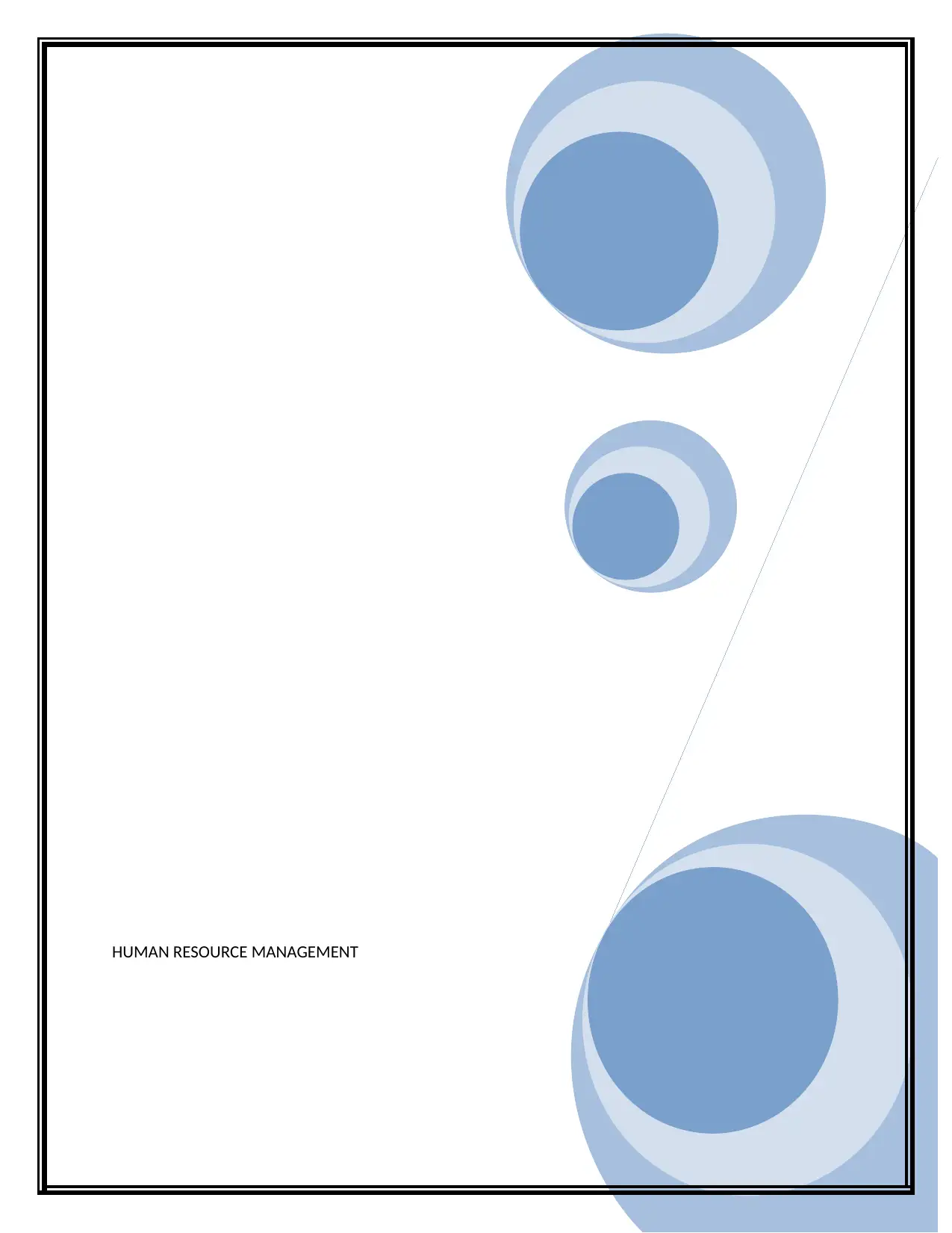
HUMAN RESOURCE MANAGEMENT
Paraphrase This Document
Need a fresh take? Get an instant paraphrase of this document with our AI Paraphraser
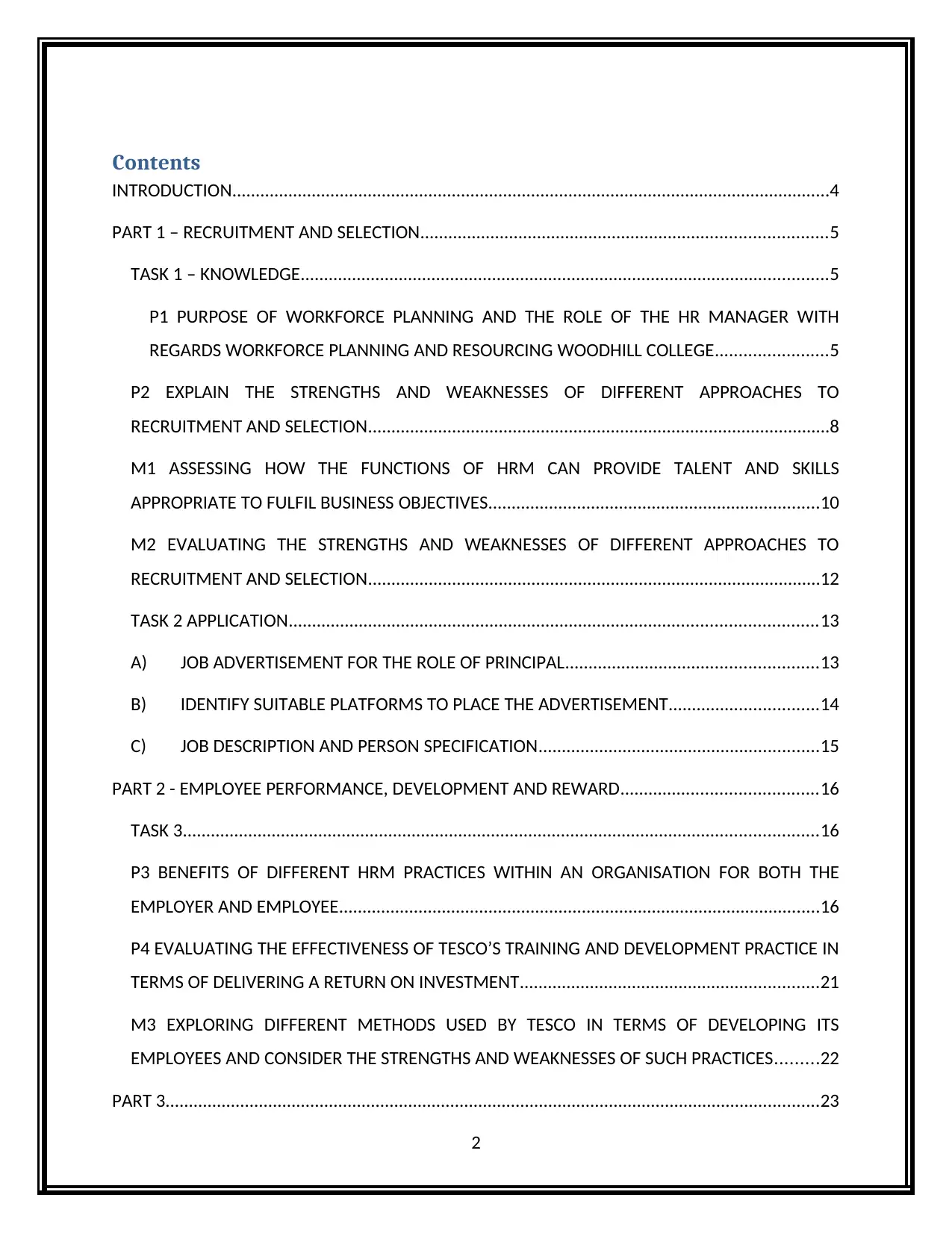
Contents
INTRODUCTION................................................................................................................................4
PART 1 – RECRUITMENT AND SELECTION.......................................................................................5
TASK 1 – KNOWLEDGE.................................................................................................................5
P1 PURPOSE OF WORKFORCE PLANNING AND THE ROLE OF THE HR MANAGER WITH
REGARDS WORKFORCE PLANNING AND RESOURCING WOODHILL COLLEGE........................5
P2 EXPLAIN THE STRENGTHS AND WEAKNESSES OF DIFFERENT APPROACHES TO
RECRUITMENT AND SELECTION...................................................................................................8
M1 ASSESSING HOW THE FUNCTIONS OF HRM CAN PROVIDE TALENT AND SKILLS
APPROPRIATE TO FULFIL BUSINESS OBJECTIVES.......................................................................10
M2 EVALUATING THE STRENGTHS AND WEAKNESSES OF DIFFERENT APPROACHES TO
RECRUITMENT AND SELECTION.................................................................................................12
TASK 2 APPLICATION.................................................................................................................13
A) JOB ADVERTISEMENT FOR THE ROLE OF PRINCIPAL......................................................13
B) IDENTIFY SUITABLE PLATFORMS TO PLACE THE ADVERTISEMENT................................14
C) JOB DESCRIPTION AND PERSON SPECIFICATION............................................................15
PART 2 - EMPLOYEE PERFORMANCE, DEVELOPMENT AND REWARD..........................................16
TASK 3........................................................................................................................................16
P3 BENEFITS OF DIFFERENT HRM PRACTICES WITHIN AN ORGANISATION FOR BOTH THE
EMPLOYER AND EMPLOYEE.......................................................................................................16
P4 EVALUATING THE EFFECTIVENESS OF TESCO’S TRAINING AND DEVELOPMENT PRACTICE IN
TERMS OF DELIVERING A RETURN ON INVESTMENT................................................................21
M3 EXPLORING DIFFERENT METHODS USED BY TESCO IN TERMS OF DEVELOPING ITS
EMPLOYEES AND CONSIDER THE STRENGTHS AND WEAKNESSES OF SUCH PRACTICES.........22
PART 3............................................................................................................................................23
2
INTRODUCTION................................................................................................................................4
PART 1 – RECRUITMENT AND SELECTION.......................................................................................5
TASK 1 – KNOWLEDGE.................................................................................................................5
P1 PURPOSE OF WORKFORCE PLANNING AND THE ROLE OF THE HR MANAGER WITH
REGARDS WORKFORCE PLANNING AND RESOURCING WOODHILL COLLEGE........................5
P2 EXPLAIN THE STRENGTHS AND WEAKNESSES OF DIFFERENT APPROACHES TO
RECRUITMENT AND SELECTION...................................................................................................8
M1 ASSESSING HOW THE FUNCTIONS OF HRM CAN PROVIDE TALENT AND SKILLS
APPROPRIATE TO FULFIL BUSINESS OBJECTIVES.......................................................................10
M2 EVALUATING THE STRENGTHS AND WEAKNESSES OF DIFFERENT APPROACHES TO
RECRUITMENT AND SELECTION.................................................................................................12
TASK 2 APPLICATION.................................................................................................................13
A) JOB ADVERTISEMENT FOR THE ROLE OF PRINCIPAL......................................................13
B) IDENTIFY SUITABLE PLATFORMS TO PLACE THE ADVERTISEMENT................................14
C) JOB DESCRIPTION AND PERSON SPECIFICATION............................................................15
PART 2 - EMPLOYEE PERFORMANCE, DEVELOPMENT AND REWARD..........................................16
TASK 3........................................................................................................................................16
P3 BENEFITS OF DIFFERENT HRM PRACTICES WITHIN AN ORGANISATION FOR BOTH THE
EMPLOYER AND EMPLOYEE.......................................................................................................16
P4 EVALUATING THE EFFECTIVENESS OF TESCO’S TRAINING AND DEVELOPMENT PRACTICE IN
TERMS OF DELIVERING A RETURN ON INVESTMENT................................................................21
M3 EXPLORING DIFFERENT METHODS USED BY TESCO IN TERMS OF DEVELOPING ITS
EMPLOYEES AND CONSIDER THE STRENGTHS AND WEAKNESSES OF SUCH PRACTICES.........22
PART 3............................................................................................................................................23
2
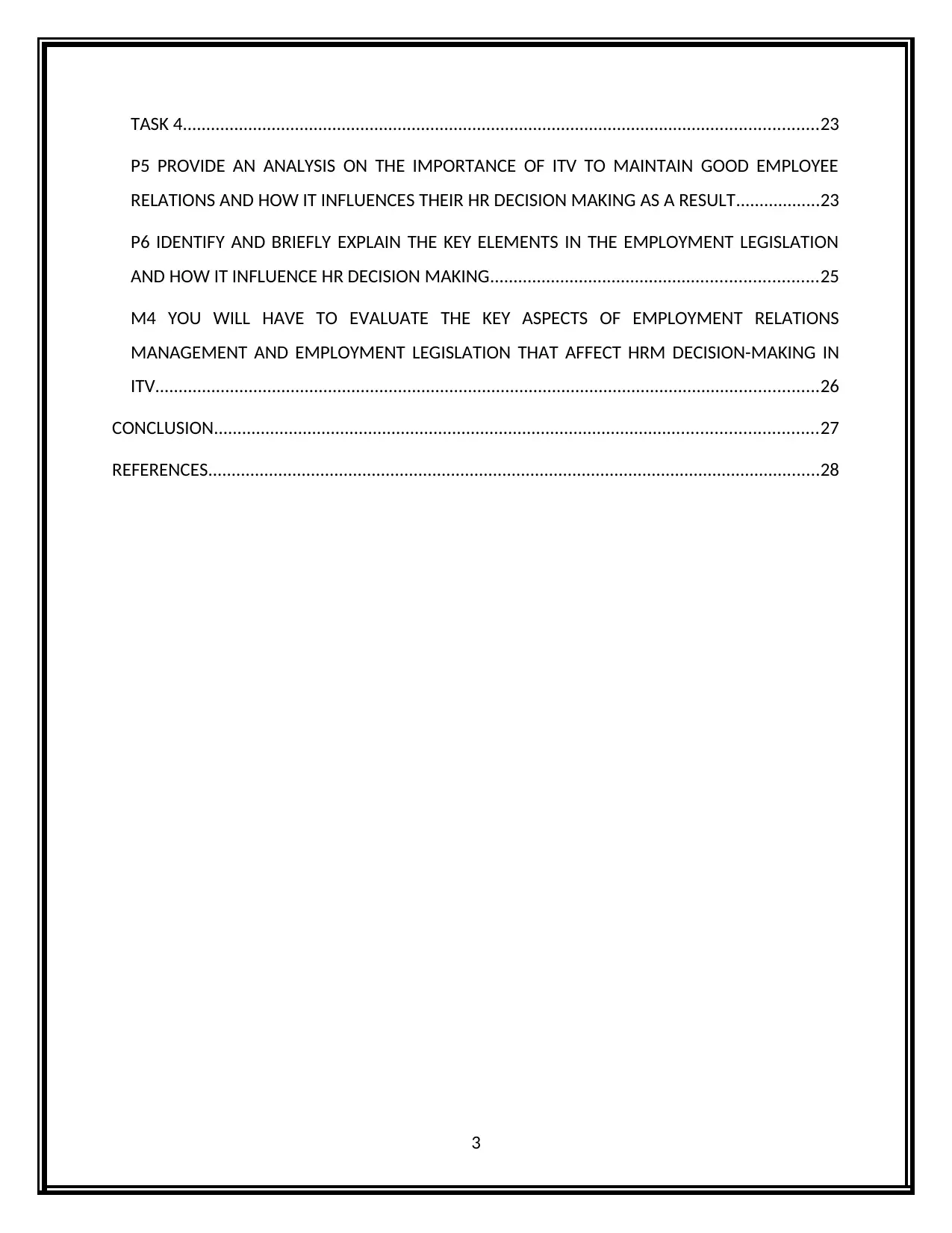
TASK 4........................................................................................................................................23
P5 PROVIDE AN ANALYSIS ON THE IMPORTANCE OF ITV TO MAINTAIN GOOD EMPLOYEE
RELATIONS AND HOW IT INFLUENCES THEIR HR DECISION MAKING AS A RESULT..................23
P6 IDENTIFY AND BRIEFLY EXPLAIN THE KEY ELEMENTS IN THE EMPLOYMENT LEGISLATION
AND HOW IT INFLUENCE HR DECISION MAKING......................................................................25
M4 YOU WILL HAVE TO EVALUATE THE KEY ASPECTS OF EMPLOYMENT RELATIONS
MANAGEMENT AND EMPLOYMENT LEGISLATION THAT AFFECT HRM DECISION-MAKING IN
ITV..............................................................................................................................................26
CONCLUSION.................................................................................................................................27
REFERENCES...................................................................................................................................28
3
P5 PROVIDE AN ANALYSIS ON THE IMPORTANCE OF ITV TO MAINTAIN GOOD EMPLOYEE
RELATIONS AND HOW IT INFLUENCES THEIR HR DECISION MAKING AS A RESULT..................23
P6 IDENTIFY AND BRIEFLY EXPLAIN THE KEY ELEMENTS IN THE EMPLOYMENT LEGISLATION
AND HOW IT INFLUENCE HR DECISION MAKING......................................................................25
M4 YOU WILL HAVE TO EVALUATE THE KEY ASPECTS OF EMPLOYMENT RELATIONS
MANAGEMENT AND EMPLOYMENT LEGISLATION THAT AFFECT HRM DECISION-MAKING IN
ITV..............................................................................................................................................26
CONCLUSION.................................................................................................................................27
REFERENCES...................................................................................................................................28
3
⊘ This is a preview!⊘
Do you want full access?
Subscribe today to unlock all pages.

Trusted by 1+ million students worldwide
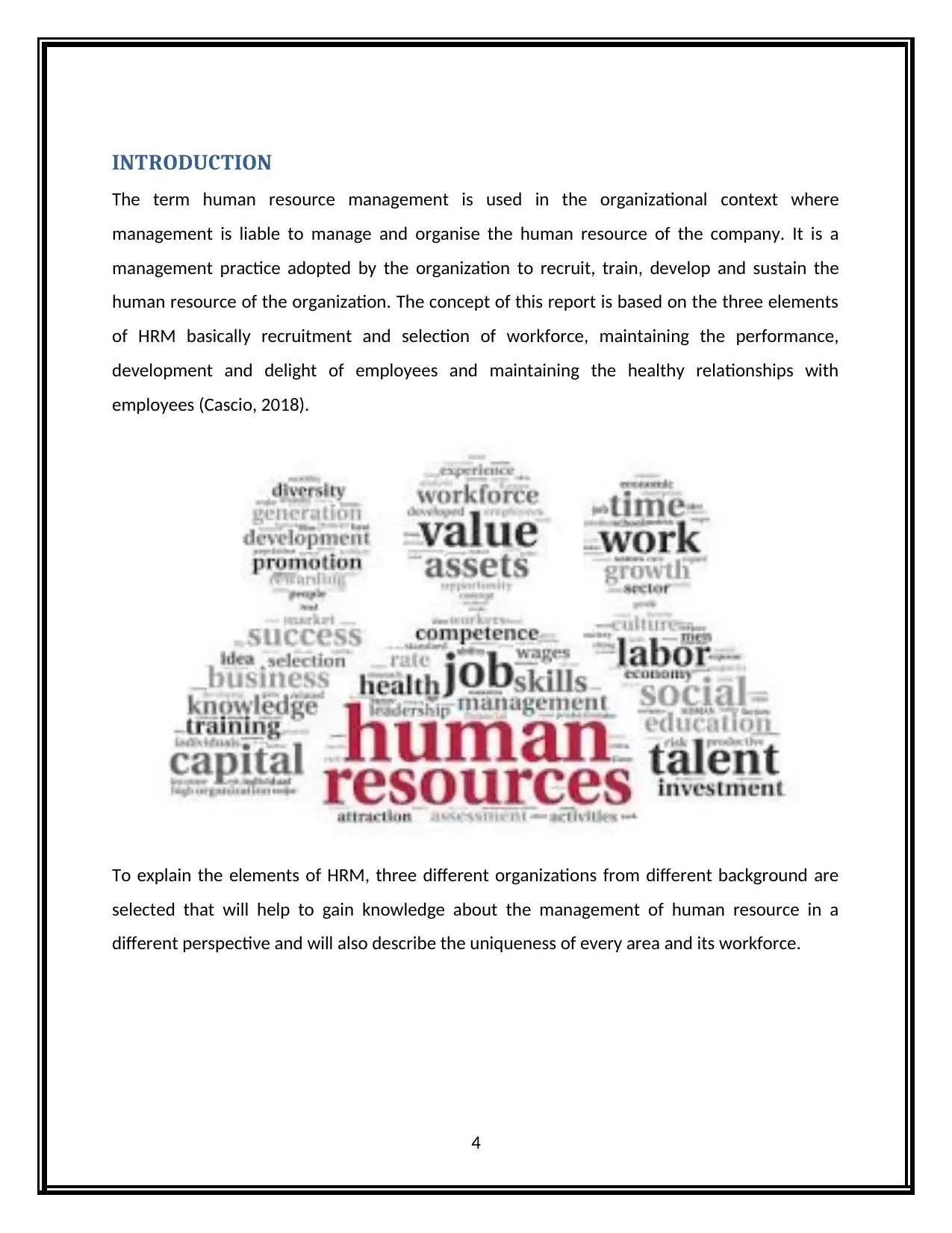
INTRODUCTION
The term human resource management is used in the organizational context where
management is liable to manage and organise the human resource of the company. It is a
management practice adopted by the organization to recruit, train, develop and sustain the
human resource of the organization. The concept of this report is based on the three elements
of HRM basically recruitment and selection of workforce, maintaining the performance,
development and delight of employees and maintaining the healthy relationships with
employees (Cascio, 2018).
To explain the elements of HRM, three different organizations from different background are
selected that will help to gain knowledge about the management of human resource in a
different perspective and will also describe the uniqueness of every area and its workforce.
4
The term human resource management is used in the organizational context where
management is liable to manage and organise the human resource of the company. It is a
management practice adopted by the organization to recruit, train, develop and sustain the
human resource of the organization. The concept of this report is based on the three elements
of HRM basically recruitment and selection of workforce, maintaining the performance,
development and delight of employees and maintaining the healthy relationships with
employees (Cascio, 2018).
To explain the elements of HRM, three different organizations from different background are
selected that will help to gain knowledge about the management of human resource in a
different perspective and will also describe the uniqueness of every area and its workforce.
4
Paraphrase This Document
Need a fresh take? Get an instant paraphrase of this document with our AI Paraphraser
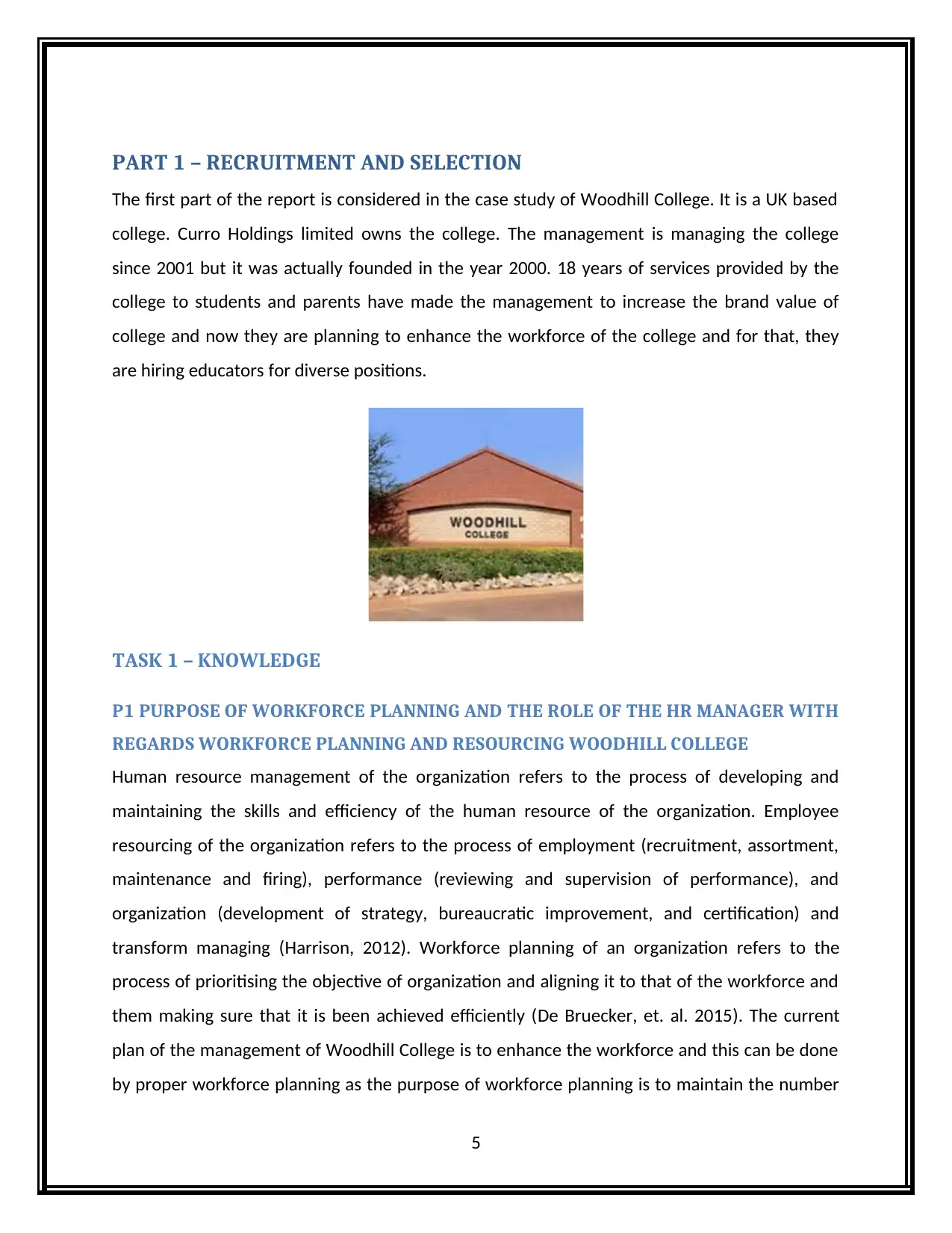
PART 1 – RECRUITMENT AND SELECTION
The first part of the report is considered in the case study of Woodhill College. It is a UK based
college. Curro Holdings limited owns the college. The management is managing the college
since 2001 but it was actually founded in the year 2000. 18 years of services provided by the
college to students and parents have made the management to increase the brand value of
college and now they are planning to enhance the workforce of the college and for that, they
are hiring educators for diverse positions.
TASK 1 – KNOWLEDGE
P1 PURPOSE OF WORKFORCE PLANNING AND THE ROLE OF THE HR MANAGER WITH
REGARDS WORKFORCE PLANNING AND RESOURCING WOODHILL COLLEGE
Human resource management of the organization refers to the process of developing and
maintaining the skills and efficiency of the human resource of the organization. Employee
resourcing of the organization refers to the process of employment (recruitment, assortment,
maintenance and firing), performance (reviewing and supervision of performance), and
organization (development of strategy, bureaucratic improvement, and certification) and
transform managing (Harrison, 2012). Workforce planning of an organization refers to the
process of prioritising the objective of organization and aligning it to that of the workforce and
them making sure that it is been achieved efficiently (De Bruecker, et. al. 2015). The current
plan of the management of Woodhill College is to enhance the workforce and this can be done
by proper workforce planning as the purpose of workforce planning is to maintain the number
5
The first part of the report is considered in the case study of Woodhill College. It is a UK based
college. Curro Holdings limited owns the college. The management is managing the college
since 2001 but it was actually founded in the year 2000. 18 years of services provided by the
college to students and parents have made the management to increase the brand value of
college and now they are planning to enhance the workforce of the college and for that, they
are hiring educators for diverse positions.
TASK 1 – KNOWLEDGE
P1 PURPOSE OF WORKFORCE PLANNING AND THE ROLE OF THE HR MANAGER WITH
REGARDS WORKFORCE PLANNING AND RESOURCING WOODHILL COLLEGE
Human resource management of the organization refers to the process of developing and
maintaining the skills and efficiency of the human resource of the organization. Employee
resourcing of the organization refers to the process of employment (recruitment, assortment,
maintenance and firing), performance (reviewing and supervision of performance), and
organization (development of strategy, bureaucratic improvement, and certification) and
transform managing (Harrison, 2012). Workforce planning of an organization refers to the
process of prioritising the objective of organization and aligning it to that of the workforce and
them making sure that it is been achieved efficiently (De Bruecker, et. al. 2015). The current
plan of the management of Woodhill College is to enhance the workforce and this can be done
by proper workforce planning as the purpose of workforce planning is to maintain the number
5
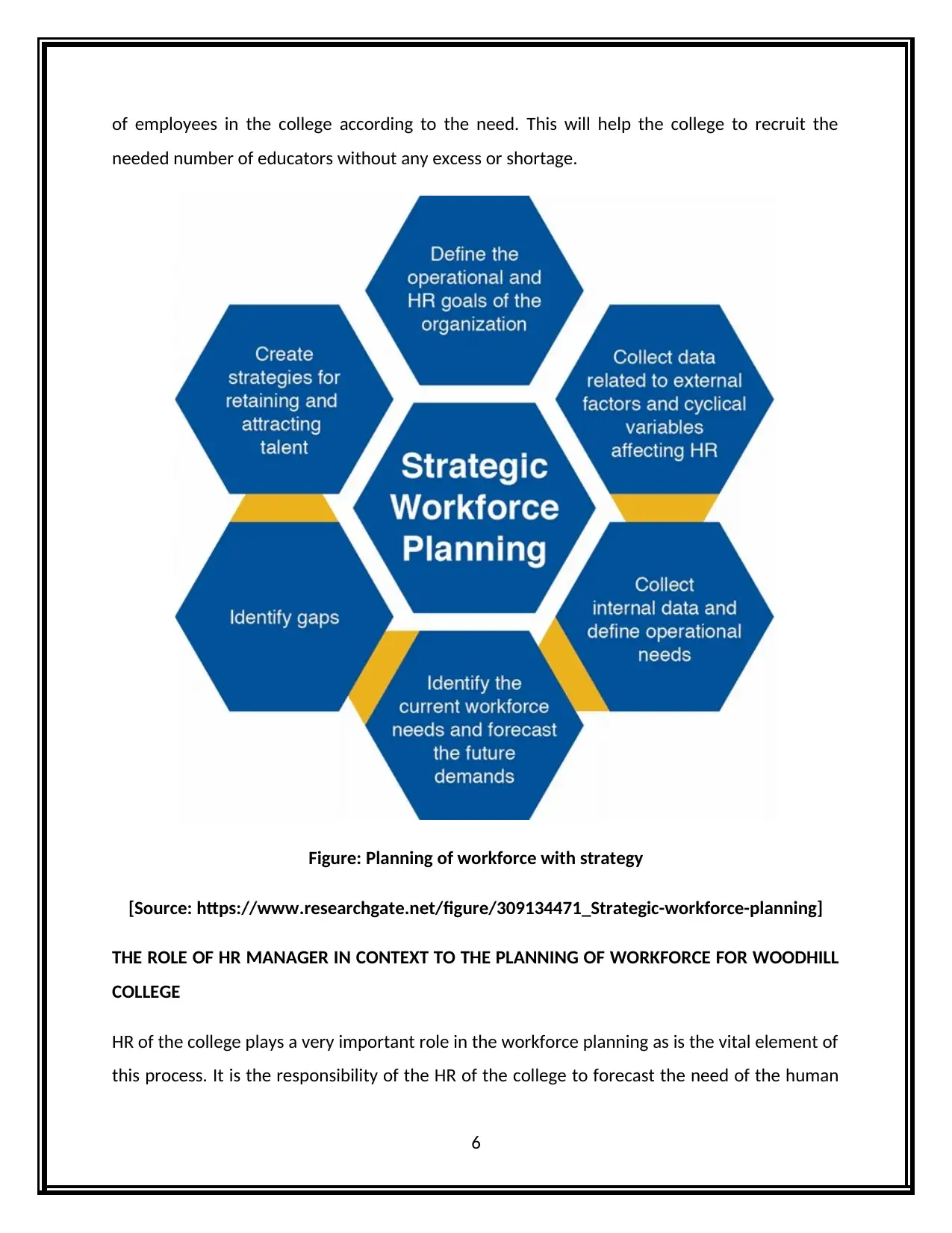
of employees in the college according to the need. This will help the college to recruit the
needed number of educators without any excess or shortage.
Figure: Planning of workforce with strategy
[Source: https://www.researchgate.net/figure/309134471_Strategic-workforce-planning]
THE ROLE OF HR MANAGER IN CONTEXT TO THE PLANNING OF WORKFORCE FOR WOODHILL
COLLEGE
HR of the college plays a very important role in the workforce planning as is the vital element of
this process. It is the responsibility of the HR of the college to forecast the need of the human
6
needed number of educators without any excess or shortage.
Figure: Planning of workforce with strategy
[Source: https://www.researchgate.net/figure/309134471_Strategic-workforce-planning]
THE ROLE OF HR MANAGER IN CONTEXT TO THE PLANNING OF WORKFORCE FOR WOODHILL
COLLEGE
HR of the college plays a very important role in the workforce planning as is the vital element of
this process. It is the responsibility of the HR of the college to forecast the need of the human
6
⊘ This is a preview!⊘
Do you want full access?
Subscribe today to unlock all pages.

Trusted by 1+ million students worldwide
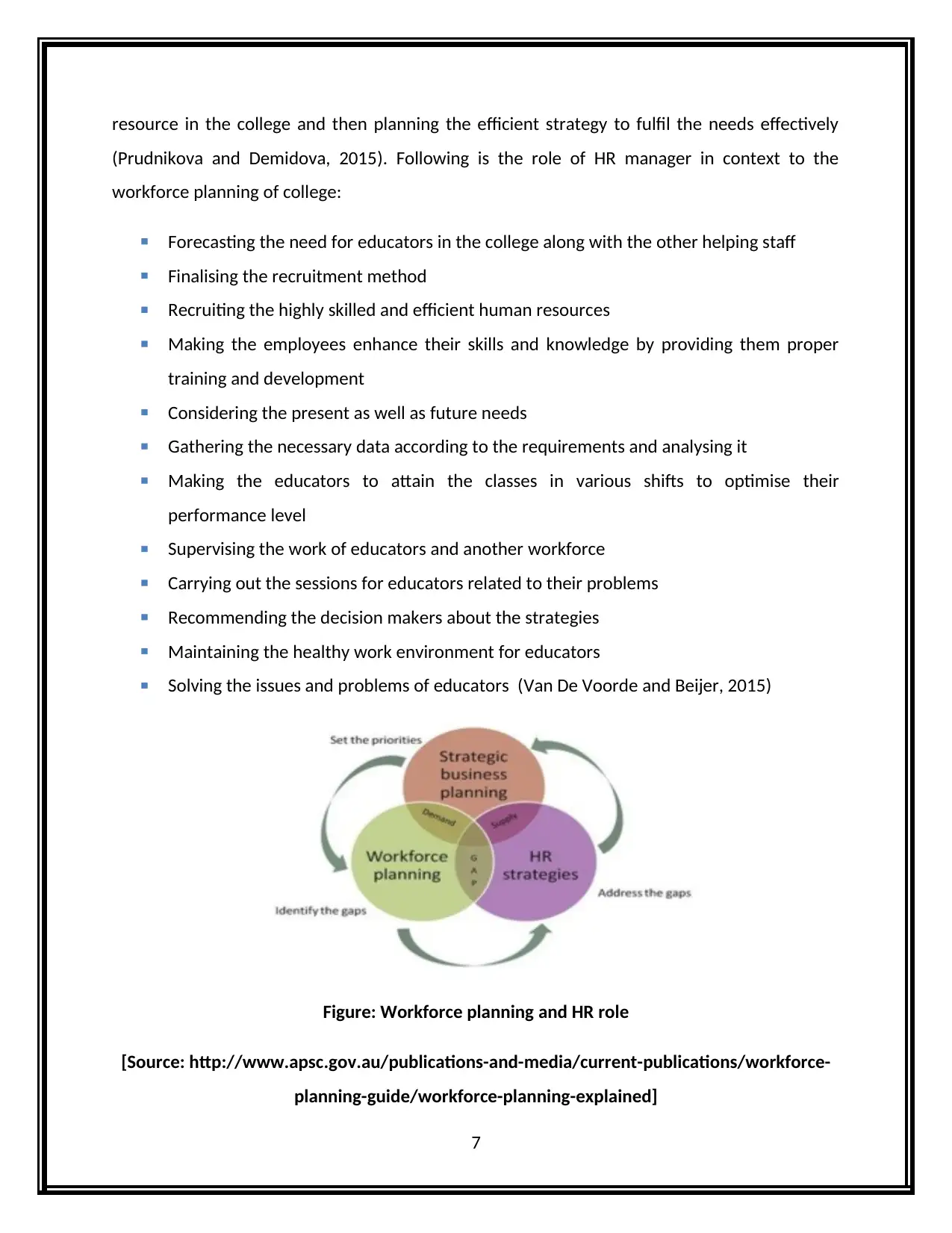
resource in the college and then planning the efficient strategy to fulfil the needs effectively
(Prudnikova and Demidova, 2015). Following is the role of HR manager in context to the
workforce planning of college:
Forecasting the need for educators in the college along with the other helping staff
Finalising the recruitment method
Recruiting the highly skilled and efficient human resources
Making the employees enhance their skills and knowledge by providing them proper
training and development
Considering the present as well as future needs
Gathering the necessary data according to the requirements and analysing it
Making the educators to attain the classes in various shifts to optimise their
performance level
Supervising the work of educators and another workforce
Carrying out the sessions for educators related to their problems
Recommending the decision makers about the strategies
Maintaining the healthy work environment for educators
Solving the issues and problems of educators (Van De Voorde and Beijer, 2015)
Figure: Workforce planning and HR role
[Source: http://www.apsc.gov.au/publications-and-media/current-publications/workforce-
planning-guide/workforce-planning-explained]
7
(Prudnikova and Demidova, 2015). Following is the role of HR manager in context to the
workforce planning of college:
Forecasting the need for educators in the college along with the other helping staff
Finalising the recruitment method
Recruiting the highly skilled and efficient human resources
Making the employees enhance their skills and knowledge by providing them proper
training and development
Considering the present as well as future needs
Gathering the necessary data according to the requirements and analysing it
Making the educators to attain the classes in various shifts to optimise their
performance level
Supervising the work of educators and another workforce
Carrying out the sessions for educators related to their problems
Recommending the decision makers about the strategies
Maintaining the healthy work environment for educators
Solving the issues and problems of educators (Van De Voorde and Beijer, 2015)
Figure: Workforce planning and HR role
[Source: http://www.apsc.gov.au/publications-and-media/current-publications/workforce-
planning-guide/workforce-planning-explained]
7
Paraphrase This Document
Need a fresh take? Get an instant paraphrase of this document with our AI Paraphraser
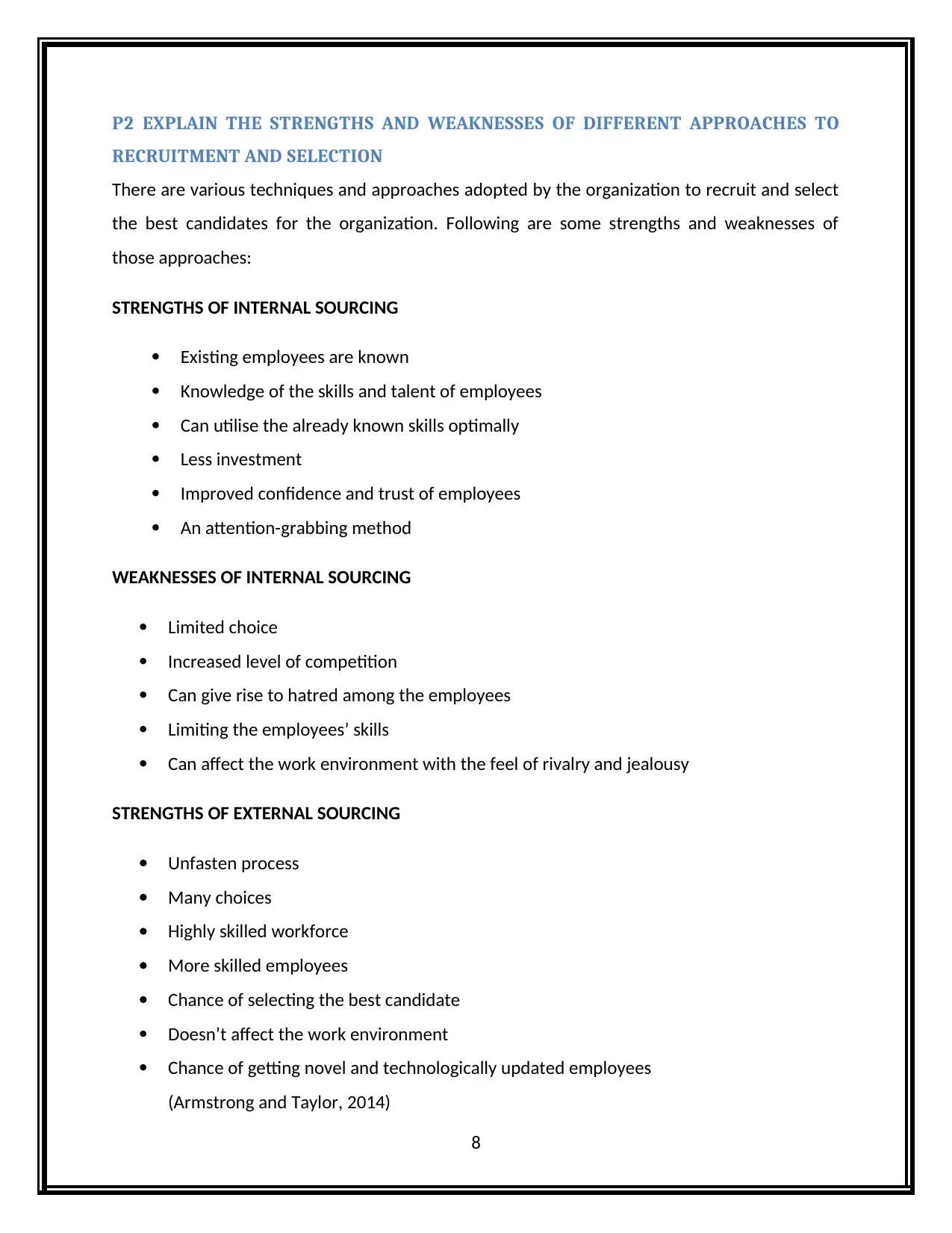
P2 EXPLAIN THE STRENGTHS AND WEAKNESSES OF DIFFERENT APPROACHES TO
RECRUITMENT AND SELECTION
There are various techniques and approaches adopted by the organization to recruit and select
the best candidates for the organization. Following are some strengths and weaknesses of
those approaches:
STRENGTHS OF INTERNAL SOURCING
Existing employees are known
Knowledge of the skills and talent of employees
Can utilise the already known skills optimally
Less investment
Improved confidence and trust of employees
An attention-grabbing method
WEAKNESSES OF INTERNAL SOURCING
Limited choice
Increased level of competition
Can give rise to hatred among the employees
Limiting the employees’ skills
Can affect the work environment with the feel of rivalry and jealousy
STRENGTHS OF EXTERNAL SOURCING
Unfasten process
Many choices
Highly skilled workforce
More skilled employees
Chance of selecting the best candidate
Doesn’t affect the work environment
Chance of getting novel and technologically updated employees
(Armstrong and Taylor, 2014)
8
RECRUITMENT AND SELECTION
There are various techniques and approaches adopted by the organization to recruit and select
the best candidates for the organization. Following are some strengths and weaknesses of
those approaches:
STRENGTHS OF INTERNAL SOURCING
Existing employees are known
Knowledge of the skills and talent of employees
Can utilise the already known skills optimally
Less investment
Improved confidence and trust of employees
An attention-grabbing method
WEAKNESSES OF INTERNAL SOURCING
Limited choice
Increased level of competition
Can give rise to hatred among the employees
Limiting the employees’ skills
Can affect the work environment with the feel of rivalry and jealousy
STRENGTHS OF EXTERNAL SOURCING
Unfasten process
Many choices
Highly skilled workforce
More skilled employees
Chance of selecting the best candidate
Doesn’t affect the work environment
Chance of getting novel and technologically updated employees
(Armstrong and Taylor, 2014)
8
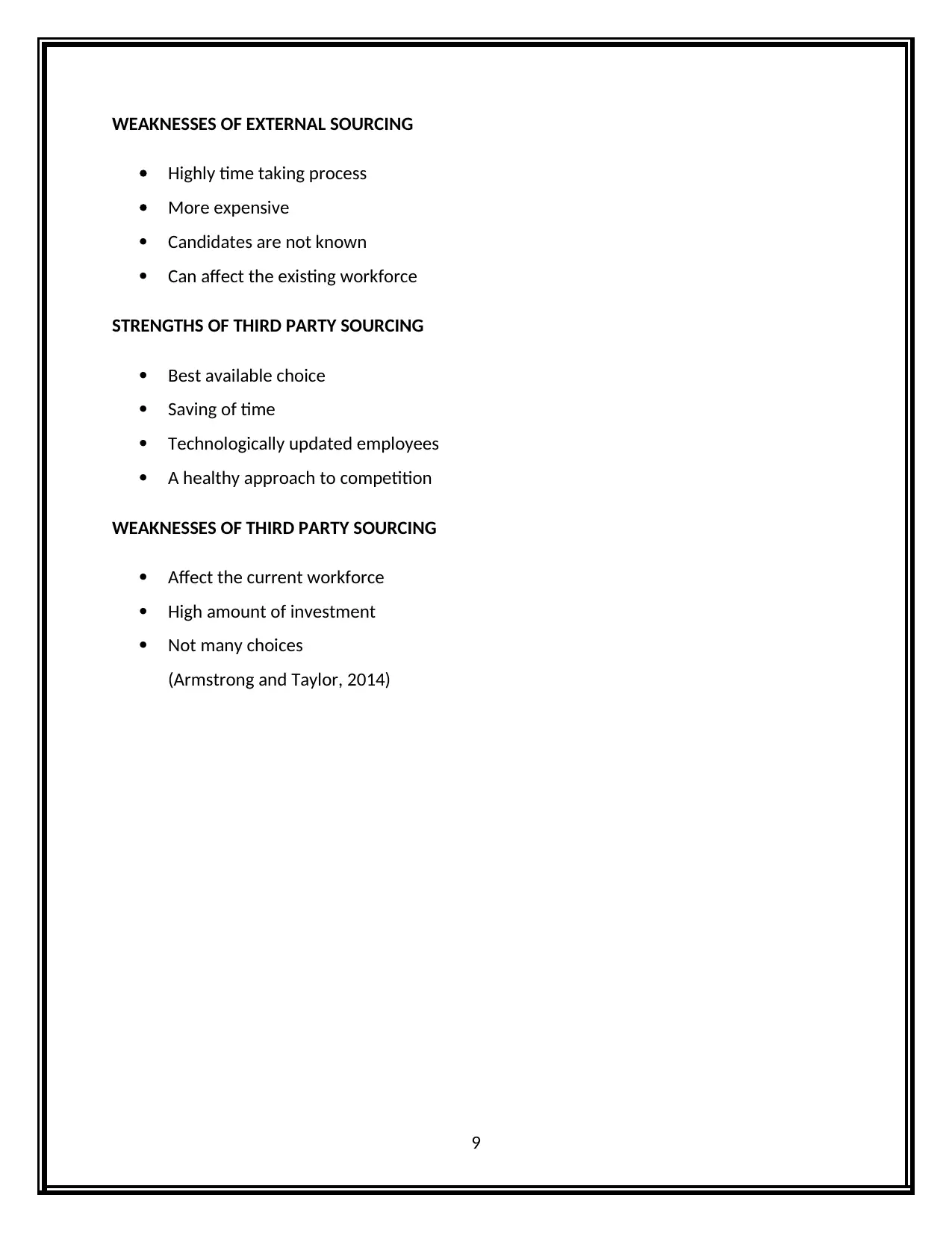
WEAKNESSES OF EXTERNAL SOURCING
Highly time taking process
More expensive
Candidates are not known
Can affect the existing workforce
STRENGTHS OF THIRD PARTY SOURCING
Best available choice
Saving of time
Technologically updated employees
A healthy approach to competition
WEAKNESSES OF THIRD PARTY SOURCING
Affect the current workforce
High amount of investment
Not many choices
(Armstrong and Taylor, 2014)
9
Highly time taking process
More expensive
Candidates are not known
Can affect the existing workforce
STRENGTHS OF THIRD PARTY SOURCING
Best available choice
Saving of time
Technologically updated employees
A healthy approach to competition
WEAKNESSES OF THIRD PARTY SOURCING
Affect the current workforce
High amount of investment
Not many choices
(Armstrong and Taylor, 2014)
9
⊘ This is a preview!⊘
Do you want full access?
Subscribe today to unlock all pages.

Trusted by 1+ million students worldwide
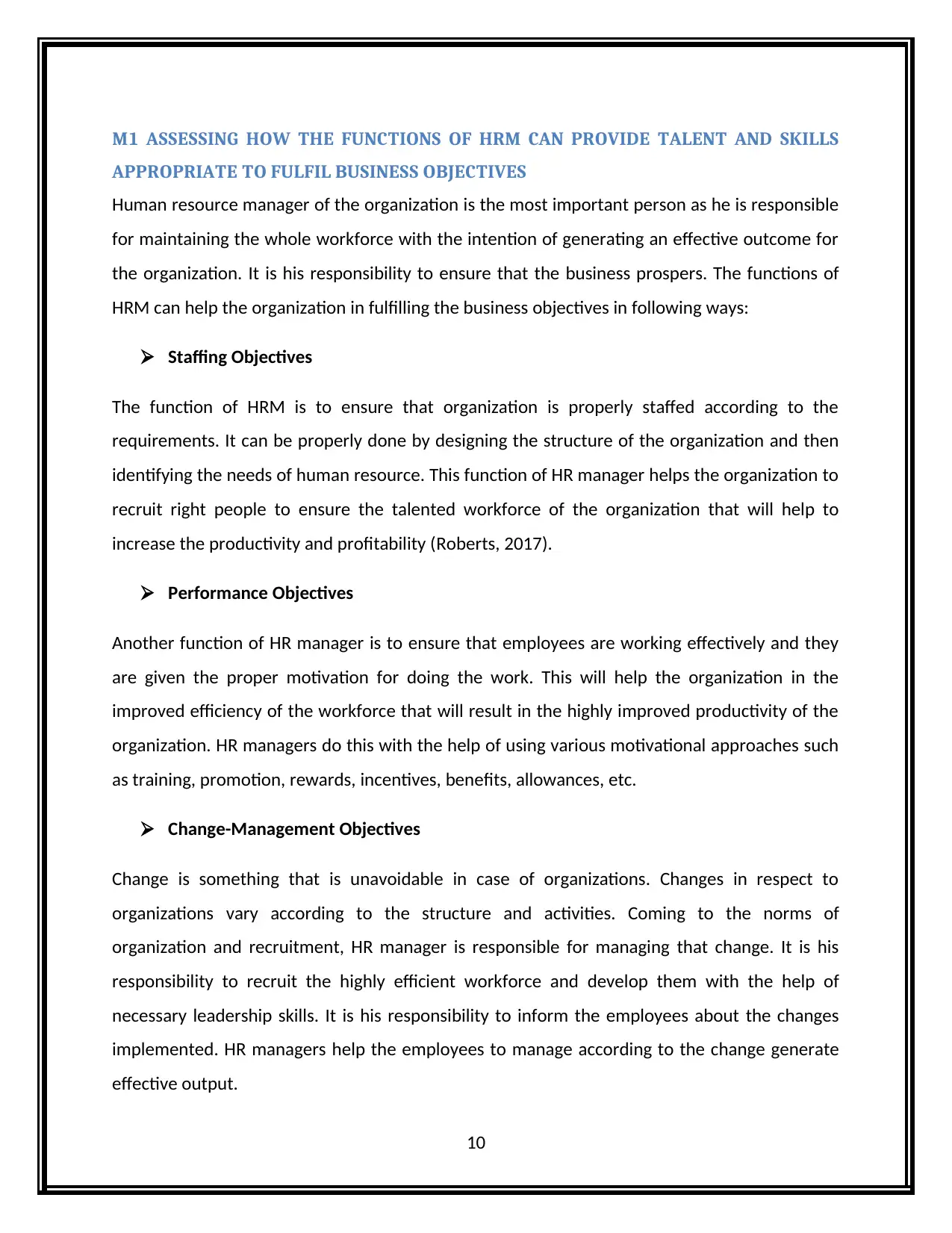
M1 ASSESSING HOW THE FUNCTIONS OF HRM CAN PROVIDE TALENT AND SKILLS
APPROPRIATE TO FULFIL BUSINESS OBJECTIVES
Human resource manager of the organization is the most important person as he is responsible
for maintaining the whole workforce with the intention of generating an effective outcome for
the organization. It is his responsibility to ensure that the business prospers. The functions of
HRM can help the organization in fulfilling the business objectives in following ways:
Staffing Objectives
The function of HRM is to ensure that organization is properly staffed according to the
requirements. It can be properly done by designing the structure of the organization and then
identifying the needs of human resource. This function of HR manager helps the organization to
recruit right people to ensure the talented workforce of the organization that will help to
increase the productivity and profitability (Roberts, 2017).
Performance Objectives
Another function of HR manager is to ensure that employees are working effectively and they
are given the proper motivation for doing the work. This will help the organization in the
improved efficiency of the workforce that will result in the highly improved productivity of the
organization. HR managers do this with the help of using various motivational approaches such
as training, promotion, rewards, incentives, benefits, allowances, etc.
Change-Management Objectives
Change is something that is unavoidable in case of organizations. Changes in respect to
organizations vary according to the structure and activities. Coming to the norms of
organization and recruitment, HR manager is responsible for managing that change. It is his
responsibility to recruit the highly efficient workforce and develop them with the help of
necessary leadership skills. It is his responsibility to inform the employees about the changes
implemented. HR managers help the employees to manage according to the change generate
effective output.
10
APPROPRIATE TO FULFIL BUSINESS OBJECTIVES
Human resource manager of the organization is the most important person as he is responsible
for maintaining the whole workforce with the intention of generating an effective outcome for
the organization. It is his responsibility to ensure that the business prospers. The functions of
HRM can help the organization in fulfilling the business objectives in following ways:
Staffing Objectives
The function of HRM is to ensure that organization is properly staffed according to the
requirements. It can be properly done by designing the structure of the organization and then
identifying the needs of human resource. This function of HR manager helps the organization to
recruit right people to ensure the talented workforce of the organization that will help to
increase the productivity and profitability (Roberts, 2017).
Performance Objectives
Another function of HR manager is to ensure that employees are working effectively and they
are given the proper motivation for doing the work. This will help the organization in the
improved efficiency of the workforce that will result in the highly improved productivity of the
organization. HR managers do this with the help of using various motivational approaches such
as training, promotion, rewards, incentives, benefits, allowances, etc.
Change-Management Objectives
Change is something that is unavoidable in case of organizations. Changes in respect to
organizations vary according to the structure and activities. Coming to the norms of
organization and recruitment, HR manager is responsible for managing that change. It is his
responsibility to recruit the highly efficient workforce and develop them with the help of
necessary leadership skills. It is his responsibility to inform the employees about the changes
implemented. HR managers help the employees to manage according to the change generate
effective output.
10
Paraphrase This Document
Need a fresh take? Get an instant paraphrase of this document with our AI Paraphraser
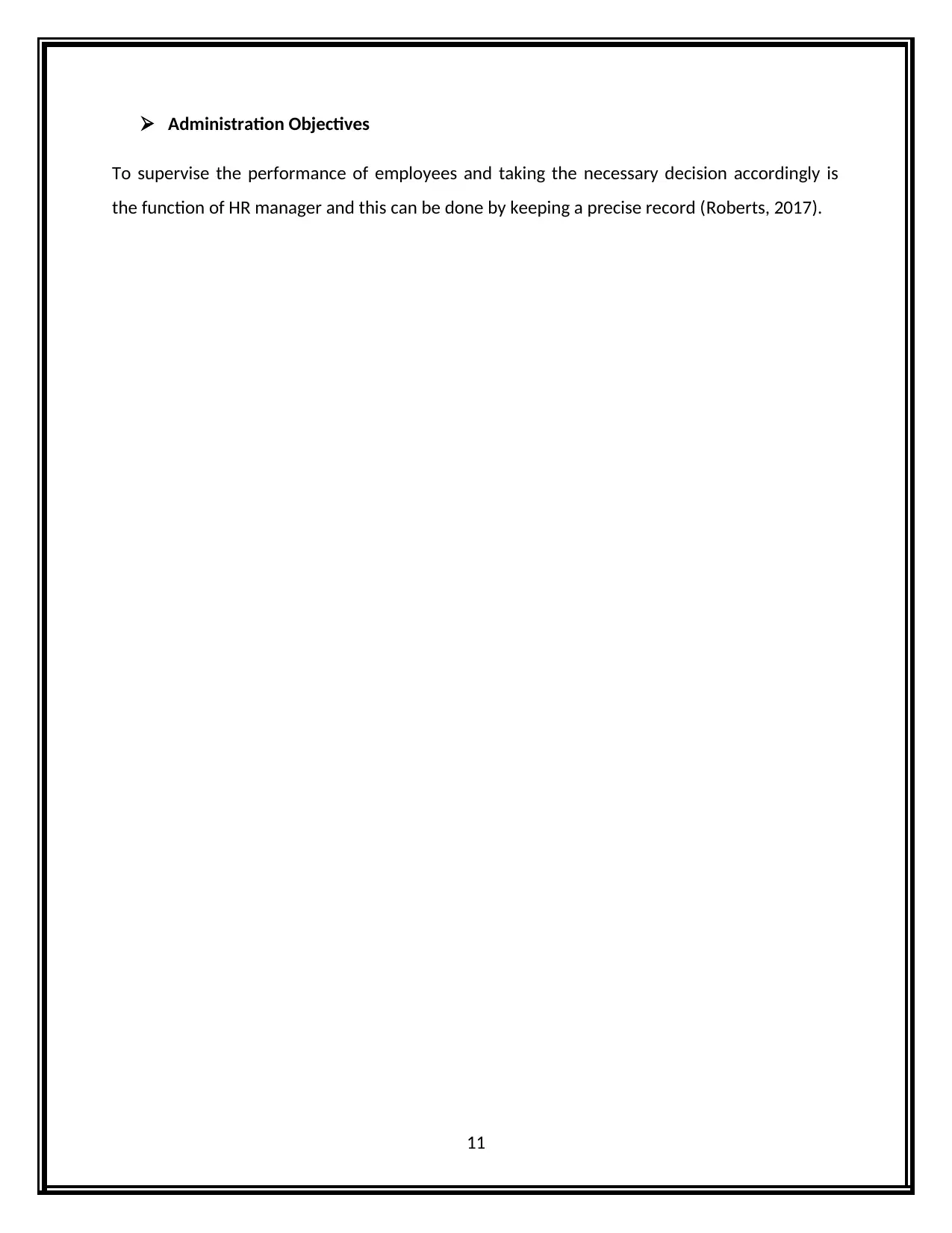
Administration Objectives
To supervise the performance of employees and taking the necessary decision accordingly is
the function of HR manager and this can be done by keeping a precise record (Roberts, 2017).
11
To supervise the performance of employees and taking the necessary decision accordingly is
the function of HR manager and this can be done by keeping a precise record (Roberts, 2017).
11
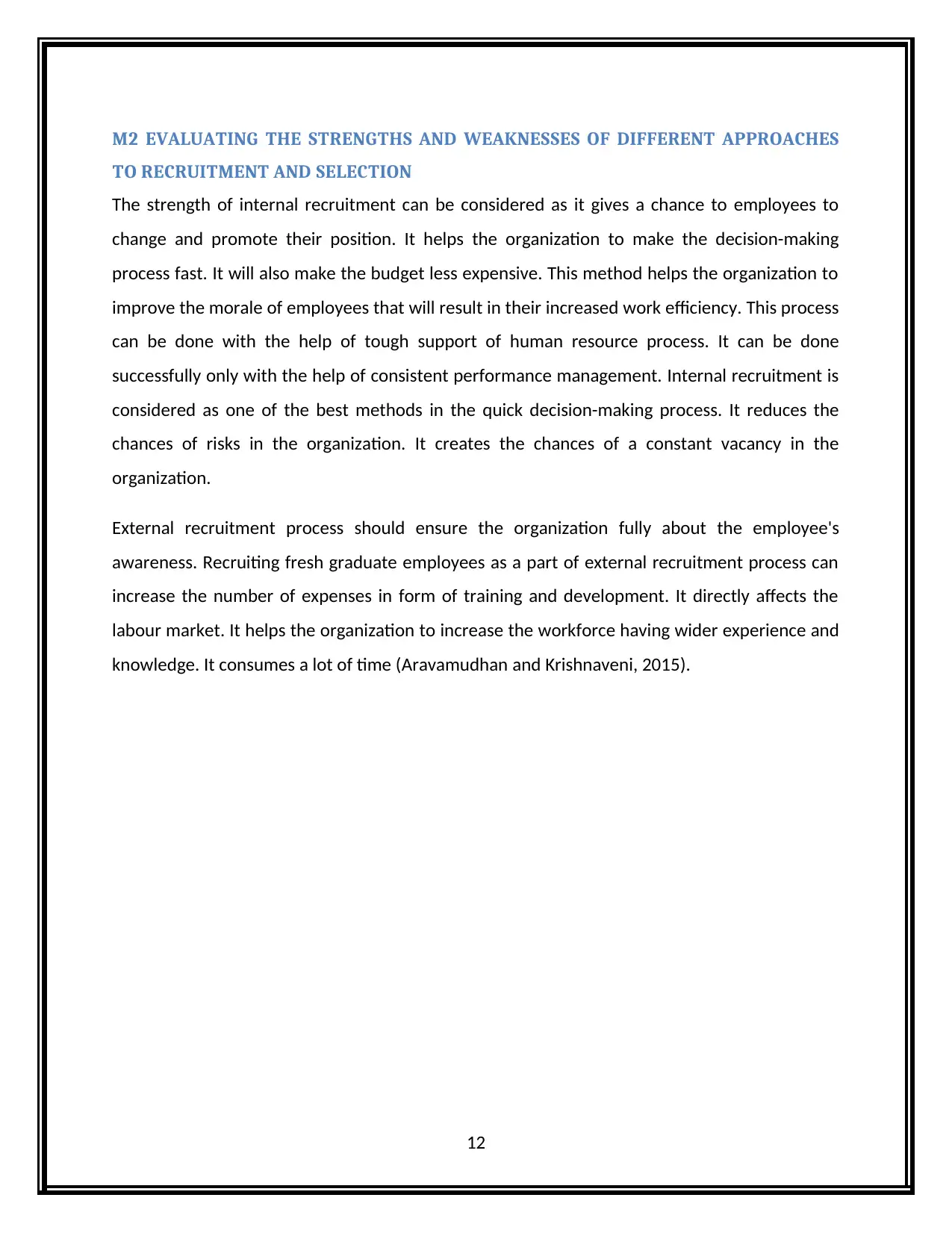
M2 EVALUATING THE STRENGTHS AND WEAKNESSES OF DIFFERENT APPROACHES
TO RECRUITMENT AND SELECTION
The strength of internal recruitment can be considered as it gives a chance to employees to
change and promote their position. It helps the organization to make the decision-making
process fast. It will also make the budget less expensive. This method helps the organization to
improve the morale of employees that will result in their increased work efficiency. This process
can be done with the help of tough support of human resource process. It can be done
successfully only with the help of consistent performance management. Internal recruitment is
considered as one of the best methods in the quick decision-making process. It reduces the
chances of risks in the organization. It creates the chances of a constant vacancy in the
organization.
External recruitment process should ensure the organization fully about the employee's
awareness. Recruiting fresh graduate employees as a part of external recruitment process can
increase the number of expenses in form of training and development. It directly affects the
labour market. It helps the organization to increase the workforce having wider experience and
knowledge. It consumes a lot of time (Aravamudhan and Krishnaveni, 2015).
12
TO RECRUITMENT AND SELECTION
The strength of internal recruitment can be considered as it gives a chance to employees to
change and promote their position. It helps the organization to make the decision-making
process fast. It will also make the budget less expensive. This method helps the organization to
improve the morale of employees that will result in their increased work efficiency. This process
can be done with the help of tough support of human resource process. It can be done
successfully only with the help of consistent performance management. Internal recruitment is
considered as one of the best methods in the quick decision-making process. It reduces the
chances of risks in the organization. It creates the chances of a constant vacancy in the
organization.
External recruitment process should ensure the organization fully about the employee's
awareness. Recruiting fresh graduate employees as a part of external recruitment process can
increase the number of expenses in form of training and development. It directly affects the
labour market. It helps the organization to increase the workforce having wider experience and
knowledge. It consumes a lot of time (Aravamudhan and Krishnaveni, 2015).
12
⊘ This is a preview!⊘
Do you want full access?
Subscribe today to unlock all pages.

Trusted by 1+ million students worldwide
1 out of 31
Related Documents
Your All-in-One AI-Powered Toolkit for Academic Success.
+13062052269
info@desklib.com
Available 24*7 on WhatsApp / Email
![[object Object]](/_next/static/media/star-bottom.7253800d.svg)
Unlock your academic potential
Copyright © 2020–2025 A2Z Services. All Rights Reserved. Developed and managed by ZUCOL.





